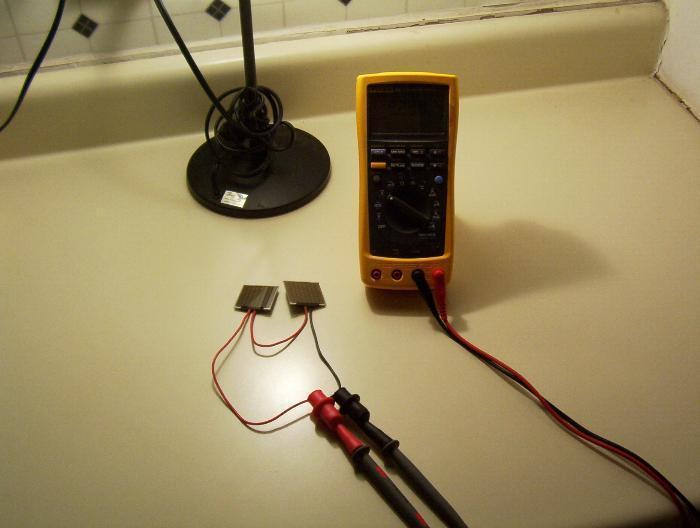
As an example let's consider I-V sweeping, the bread and butter of semiconductor testing. Most of the basic values of a solar cell can be determined from a quick IV check. One of those values, the short circuit current (Isc), helps determine the maximum power a cell could theoretically produce. A high Isc is nice to have.
But as I tested larger and better cells, with more total current output, I ran into limitations with the NI approach. I couldn't measure an Isc above 2 amps. This confused me somewhat, since I had seen the the five amp limit on the NI page. Adding insult to injury, I didn't even need the SMU to output that current - the solar cell was generating the current.
I then considered connecting multiple SMUs. There is a "knowledge base" article on the NI website that supposedly answers the question, "What is the Maximum Voltage and Current that the NI DC Power Supplies can Source when Cascading Outputs?" But nowhere on that page does it list a maximum current. I even found a Photovoltaic Solar Cell I-V Characterization Bundle page that says you can "add more SMUs to get three times the voltage or current." I struggled with this problem for a month.
Well, I finally got an answer from NI last week. The SMU cannot measure above 2A current because the PXI chassis has to dissipate the power, regardless of where the current source is. The chassis has "a hard limit on the amount of power consumed by each of the SMUs." In other words, National Instruments has some cleaning to do on their website.
------------------------
So what's the moral of this rant? First, I'm going to get a different power supply (maybe Agilent). Second, you cannot always trust the hardware verbage you read online.

3 comments:
Hi Greg -
Sorry if the information on ni.com was not clear. This is Travis White - NI product manager.
The NI PXI-4130 Power SMU can source 20V, 2A (40W max) per module but can only sink 10W max. This info can be found in the NI PXI-4130 specifications here.
As mentioned in the linked bundle, multiple PXI-4130 modules can be used in parallel to sink more power. The 10W limit per module still applies. We've seen engineers choose both parallel and series combinations of PXI SMU modules for solar cell and solar panel test.
The APS-4100 Auxiliary Power Source is an external supply that provides additional power to the PXI-4130. This 12V/5A power is regulated by the PXI-4130 to provide the aforementioned 20V, 2A 4-quadrant output available to the user. I will take the action item of updating the APS-4100 web page to be more clear that the 5A specification refers only to the APS-4100 (not the output available on the PXI-4130).
We appreciate the feedback on your post - if you have more feedback for us, please feel free to give me a ring at 512.683.0100.
Travis,
Thanks for the clarifications. But the app engineer I talked with at NI said I should not link the 4130 modules in series for more current in an IV sweep. Furthermore, the 10W limit isn't an issue for me as much as the current limit is. If I cannot get above 2A, even at low voltage, then that remains a problem.
Hi Greg -
Thanks for the additional detail - perhaps there was a miscommunication via the app engineer regarding sinking vs. sourcing.
When sinking (dissipating power from an external source such as an illuminated solar cell), multiple PXI-4130 modules can be "ganged" in parallel for higher current. With 2 PXI-4130 modules you can sink up to 4A.
However, multiple PXI-4130 modules cannot be ganged in parallel to source higher current. This limitation is commonly seen on 4-quadrant devices due to their ability to freely switch between sinking and sourcing, which can result in oscillations when there are parallel SMUs attempting to source. Again, when parallel SMUs are sinking, there is no issue.
Finally, the PXI-4130 can also be "stacked" in series for higher voltage. This applies to both sourcing and sinking operation.
Again, I apologize for any lack of clarity in the information we provided - please let me know if I can help out more.
Post a Comment